A morning coffee or some evening tea is an essential part of the day – hands up if you can’t function without it!
One key ingredient to a good brew is a clean kettle. Things like dirt, dust, and limescale can affect the water’s taste and ruin your drink.
How to clean a kettle? It’ll depend on the material – but common cleaning solutions include dish soap, baking soda, distilled white vinegar, lemon juice, and citric acid.
You may only be putting water in a kettle (no milk or cocoa!), but it still needs cleaning. That’ll keep your kettle safe, hygienic, and long-lasting – and keep your favourite brew tasting delicious, day after day.
Electric vs Stovetop Kettles | Before Cleaning | Aluminium Kettle | Cast Iron Kettle | Ceramic Kettle | Copper Kettle | Glass Kettle | Plastic Kettle | Stainless Steel Kettle | Cleaning the Filter | Cleaning the Exterior | Descaling a Kettle | Cleaning a Burnt Kettle | FAQs
How Often to Clean a Kettle
This will depend on how often you use the kettle, but regular cleaning is essential to minimise dirt and mineral buildup.
You can rinse and dry your kettle after every use (or at the end of the day). Do not leave water inside for extended periods.
Spot clean the exterior of the kettle weekly to remove limescale and dirt from drips, spills, and general use.
Wash or descale the filter once every two months (or based on the manufacturer’s directions).
Descale a kettle every 2-3 months – or at least every 4 months. But if you notice an odd taste in your tea, clean and descale the kettle ASAP.
Stovetop Kettles vs Electric Kettles
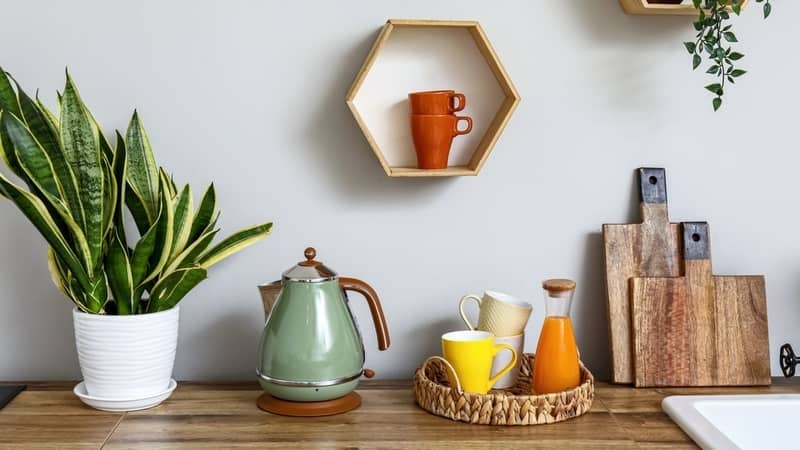
An electric kettle (or electric tea kettle) has two parts – the kettle itself and the base, which contains the heating element.
When plugged in, the heating element transfers the heat to the kettle and the water inside. Electric kettles typically heat water much faster than stovetop kettles.
Many models automatically switch off once the water has boiled. More expensive models have temperature settings or even a “keep warm” function!
Meanwhile, stovetop kettles have been around for generations. They’re set on top of a burner (or in newer models, an induction cooker) and left until the water boils.
These kettles can take longer to boil (up to 20 minutes) and do not have automatic shutoffs, so you’ll need to listen for the “whistle” of boiling water.
However, they don’t require electricity to work, so that’s one less socket needed in the kitchen.
Cleaning Different Types of Kettles
There are two main types of kettles: electric and stovetop. The methods for cleaning and descaling both kettles are similar.
Cleaning an electric kettle
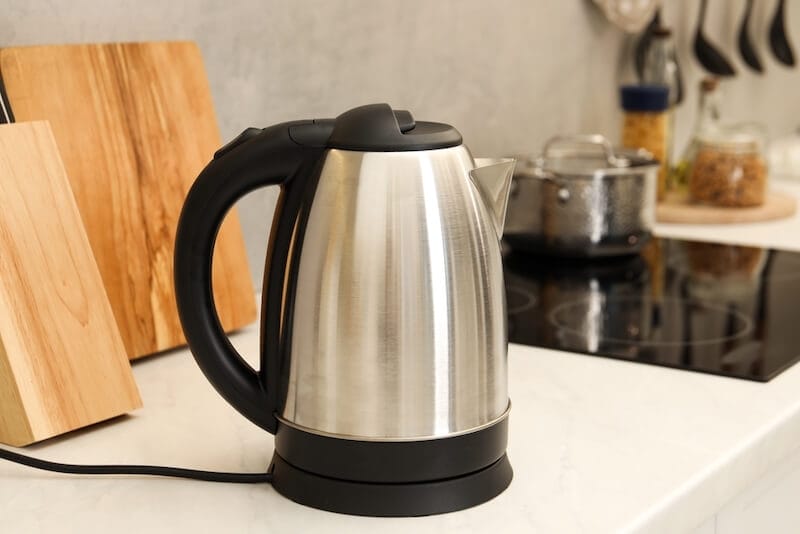
When cleaning an electric kettle, you’ll need to be careful. Heating elements cannot get wet or you could damage your kettle’s mechanisms.
Leftover moisture could even cause a short and create a fire risk.
Do not submerge an electric kettle or rinse the bottom/base with running water.
To clean the bottom of an electric kettle, you can simply wipe the surface with a lightly dampened cloth. Avoid getting the heating element wet and dry everything thoroughly.
Cleaning a stovetop kettle
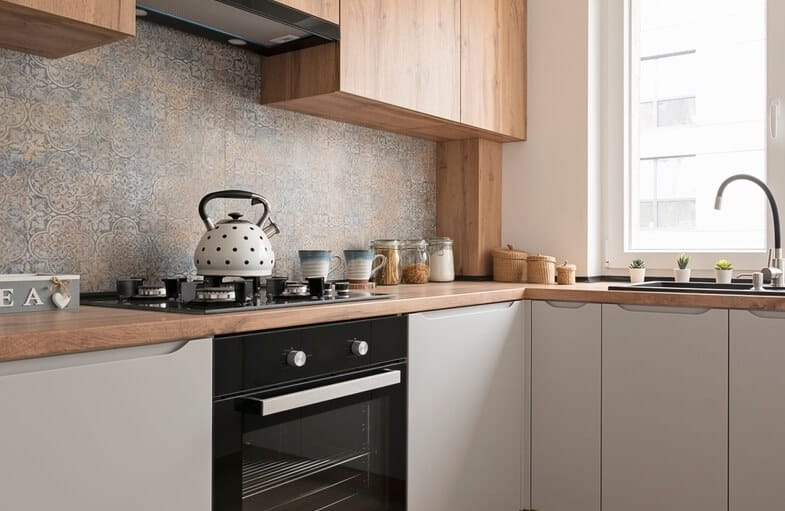
Stovetop kettles are also easier to clean since you don’t need to be mindful of any heating elements.
Most stovetop kettles are made of metal or ceramic, which can be cleaned with dish soap, white vinegar, and other household ingredients.
You’ll need to pay special attention to the underside, especially if you own a gas stove. Soot, burn marks, and other dirt builds up and needs scrubbing off.
Before Cleaning a Kettle
If you’re not descaling the kettle, then you’ll have to unplug it and wait for it to cool completely.
To clean a kettle, you’ll need:
- A non-abrasive sponge or soft-bristled bottle brush
- Microfiber cloth
- Dish soap of choice
- Descaler of choice
Check the manufacturer’s instructions on how to remove the filter if your kettle has one.
You may need a thin, flexible brush (like a straw cleaner) if your kettle has a long spout. Gooseneck kettles may come with their own cleaning implements for the signature long spout.
Avoid metal brushes and other abrasive cleaners, as these could damage the finish or mechanisms.
Unless stated otherwise by the manufacturer, you should not wash a kettle in the dishwasher.
How to Clean Tea Kettles by Material
How you clean a kettle depends on the material! You can’t clean copper in the same way you’d clean glass, for example.
No matter the cleaning method, you can wash out any lingering residue and odours with some dish soap and water. Dry the kettle with a microfibre cloth to remove excess moisture.
And of course, don’t forget to clean the spout!
Cleaning an aluminium kettle
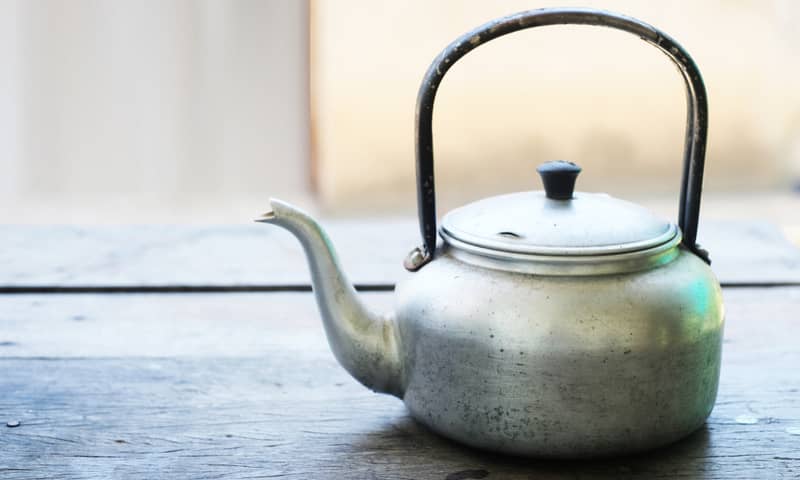
Aluminium is an affordable and versatile material, but it can scuff easily. Avoid abrasive or harsh cleaners that can scratch the aluminium surface.
Fill the kettle halfway with hot, soapy water and let it sit for 10-15 minutes. Then use a soft-bristled brush to scrub the kettle inside and out.
Thoroughly rinse the kettle to remove any soap residue, then wipe it dry immediately. Leftover moisture can lead to rust or water spots.
Cleaning a cast iron kettle
Cast iron isn’t typically used for stovetop kettles these days, but you could find one in your grandmother’s kitchen or a thrift shop.
Like other cast iron cookware, it’s best not to expose your kettle to moisture when not in use or it could rust.
But you can absolutely clean cast iron with mild dish soap and warm water – just make sure to rinse and dry the kettle thoroughly.
Protect the iron by applying a very thin coat of vegetable oil onto the entire kettle, then wipe off the excess.
Cleaning a ceramic kettle
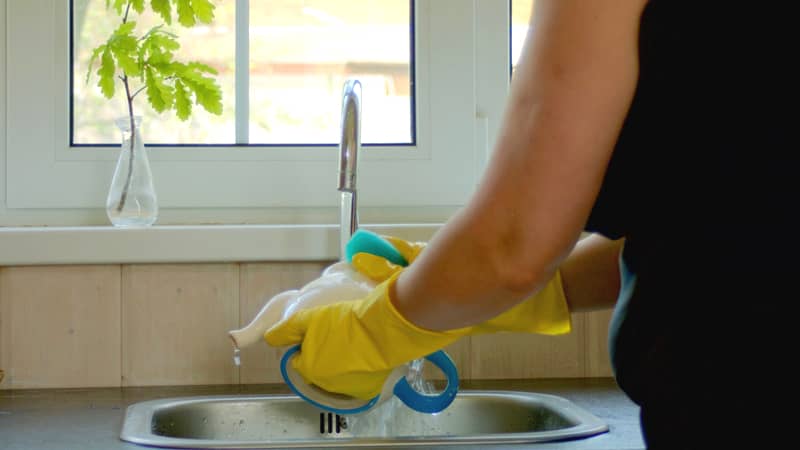
Ceramic kettles are great choices since they often have sleek or intricate designs. They’re made of natural materials that are typically scratch-resistant and rust-free.
Make sure you get your ceramic kettle from a reputable brand so you know the glaze is free of heavy metals (like lead or cadmium).
Ceramic can accumulate limescale, but less than aluminium or stainless steel. To clean a ceramic kettle, you can simply wash it in soapy water with a soft sponge.
Alternatively, mix equal parts white vinegar and warm water in a spray bottle with a few drops of dish soap. Spray down your kettle, then use a damp cloth to wipe it clean.
Rinse and dry the kettle thoroughly.
Cleaning a copper kettle
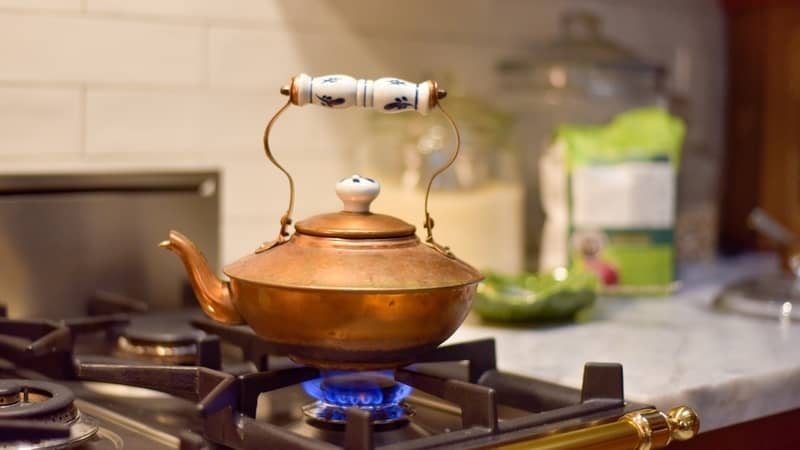
Copper kettles are difficult to maintain as copper tarnishes easily. Commercial cleaners can damage the metal, and excess moisture can cause rust.
Check if your kettle is fully copper or simply copper-plated – if a magnet sticks, it’s not pure copper.
You can clean a stovetop copper kettle using a mix of either vinegar or lemon juice and salt. Mix a tablespoon of salt per cup of vinegar or lemon juice, then dip a soft cloth into the cleaning solution.
Gently scrub the copper surfaces in circular motions to remove any dirt and tarnish.
Alternatively, mix some lemon juice with flour to make a paste. Apply to the copper kettle, then let it sit for 10-15 minutes.
Rinse with warm water, then dry thoroughly so there’s no moisture left.
Cleaning a glass kettle
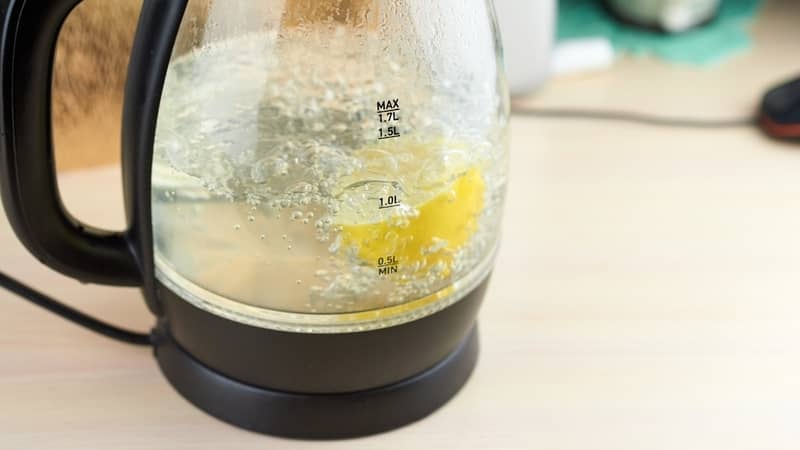
Glass kettles are very aesthetic, especially if you use flower-type teas. Borosilicate glass is the “safest,” but there are tempered glass kettles as well.
These types of kettles are non-porous, durable, and non-rusting. However, they may scratch or chip if improperly handled, and may stain if you don’t clean them regularly.
One of the best ways to remove stains and keep your electric glass kettle clean? Lemons!
To clean a kettle with a lemon, start by cutting it in half. Squeeze all the juice into the kettle, then fill it halfway up with cold water.
Let the lemon-water solution boil, then remove the kettle from heat or switch it off. Then let the lemon water sit until the kettle has cooled.
Use a soft sponge or bottle brush to scrub the interior, then pour the mixture out. Rinse thoroughly, then boil one to two batches of fresh water to remove the citrusy taste.
Cleaning a plastic kettle

The more affordable electric kettles are made of plastic – ideally BPA and PFA-free. They’re convenient, but have a shorter lifespan than other types of kettles and can crack, warp, or break more easily.
However, plastic is easy to clean and does not accumulate limescale.
To clean a plastic kettle, you can simply wash it with dish detergent and water – just be mindful of the bottom! Rinse the kettle thoroughly, then dry.
For a deeper clean, make a paste out of baking soda and water. Use a soft sponge to apply the paste all over the kettle, then let it sit for a few minutes.
Take an old toothbrush or soft-bristled brush, then gently scrub inside the kettle and spout. Rinse thoroughly with clean water, then do a quick boil to remove any residue and taste.
Cleaning a stainless steel kettle
Many modern kettles – both electric and stovetop – are made of stainless steel, since it’s a durable and versatile material. High-quality steel is rust-resistant and maintains heat for a long time.
To clean a stainless steel kettle, fill the kettle halfway with equal parts white vinegar and water. Boil the solution, then remove the kettle from the stove or switch it off.
(You may want to switch on a fan and open the windows – the smell can get funky!)
Let it sit for 10-20 minutes while the kettle cools, then add a few drops of dish soap inside. Use a bottle brush or non-abrasive sponge to scrub gently.
Discard the vinegar solution, then rinse the kettle’s interior with fresh water. Boil one or two batches of clean water to remove the lingering vinegar taste and odour.
For stubborn residue, try the baking soda paste – separate from vinegar.
NOTE: As an optional step, you can polish a stainless steel kettle with a bit of olive oil or other neutral oil. Apply a thin layer of olive oil with a soft cloth all over the kettle, then wipe off the excess and let it dry.
How to Clean a Kettle Filter
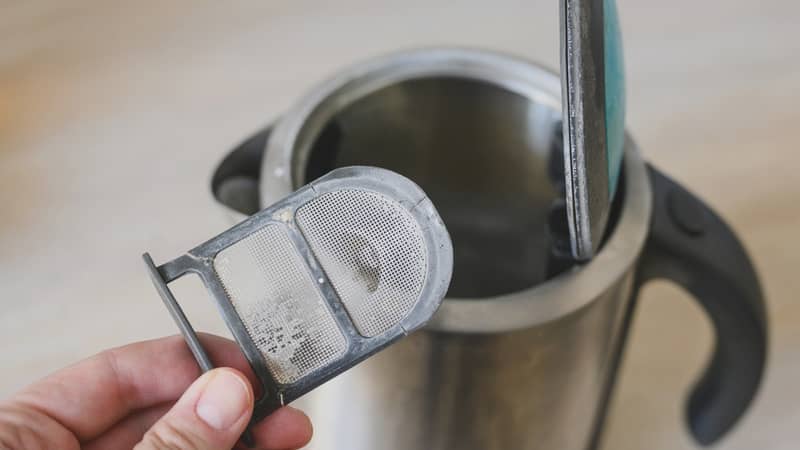
Check the manufacturer’s directions on how to remove and clean the kettle filter. Most of the time, you can simply let it soak in a mix of hot water, vinegar, and dish detergent.
Leave for 5-10 minutes, then scrub with a sponge or soft-bristled brush.
If the limescale buildup is too crusty or tough, you may need to replace the filter.
How to Clean a Kettle’s Exterior
To clean the outside of a kettle, simply wipe the surfaces and handle clean with a damp cloth dipped in soap and water.
For limescale on the outer surface of the kettle (like from drips or spills), wipe it down with a cloth dampened in some white vinegar and water.
Follow with a fresh, damp cloth, then thoroughly dry.
If there’s a grease splatter or food residue on your kettle, use the baking soda paste. Apply it to the affected areas and let it sit for 5-10 minutes to absorb the mess.
Wipe the baking soda off with a damp cloth, then rinse the kettle (carefully!). Follow with a dry cloth.
When to Descale a Kettle
Powdery white residue inside your kettle is a sign of mineral buildup, and means you’ll need to clean or descale soon.
Always work in a well-ventilated room, especially if you’re using vinegar! Otherwise, the pungent odour can build in your kitchen – and no one wants to smell vinegar all day.
What causes limescale build-up?
If you live in a hard water area (and if you don’t have a softener installed), the water will leave mineral deposits called limescale inside the kettle.
These minerals – such as calcium carbonate and magnesium – will build up on the kettle’s surfaces. The residue looks white or off-white and feels gritty, like a hardened powder.
Limescale (also called kettle furring!) by itself isn’t dangerous for your health, but it looks unattractive. Letting it build up can also lead to mould or bacteria growth.
Descaling a kettle
There are several ways to descale a kettle – the most popular methods use distilled white vinegar, lemon juice, or citric acid powder.
Mix your chosen descaler with water inside the kettle, then bring to a boil. Scrub the limescale off, then rinse the kettle thoroughly.
You can also use a commercial kettle descaler, like the Breville Eco Liquid Descaler or WoldoClean Descaler Tablets.
NOTE: Commercial descalers are generally not recommended for glass kettles, so opt for the more natural solutions.
Cleaning a Burnt Kettle
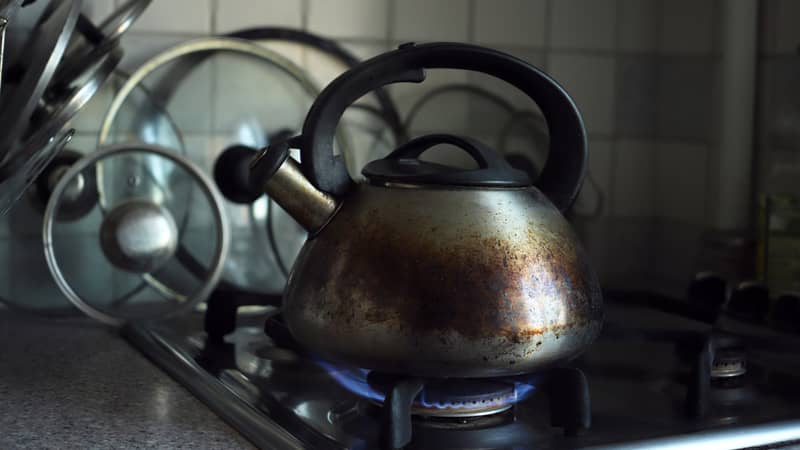
If you’ve scorched the surface or underside of your kettle, don’t panic! The easiest way to remove burn marks on a kettle is with a paste of baking soda, dish soap, and hot water.
Apply the paste to the burnt area with a sponge and let it sit for up to an hour. Then use the sponge to scrub the burn marks off.
If that doesn’t work, try adding 1 tbsp of citric acid to half a litre of water in the kettle. Bring that to a boil, then let it soak for 10 minutes.
Swirl the mixture around, then pour it out. Scrub any remaining marks off with a sponge.
Rinse the kettle clean, then wipe it dry.
FAQs and Tips For Cleaning a Kettle
Here are some answers to common questions about kettle cleaning, as well as some handy tips!
Can I prevent limescale buildup in a kettle?
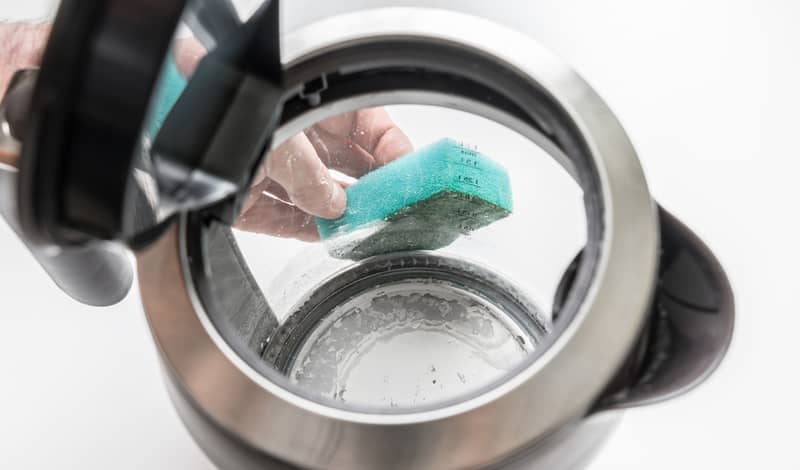
Unless you have a water filter or softener, your water will contain natural minerals that build up over time. But there are ways to minimise limescale buildup in your kettle.
Only boil as much water as you’ll need each time. You can pour leftover water down a sink drain to clean it, or use it to rinse dirty dishes.
Don’t let water sit in the kettle – empty the reservoir at the end of each day.
Install a water softener or filter if possible.
Does boiling vinegar clean a kettle?
Boiling distilled white vinegar is a popular method of cleaning and descaling a kettle! Use a bottle brush afterwards to scrub the kettle clean.
Some people prefer to use lemon juice or citric acid instead of vinegar, as boiled vinegar can unleash a pungent odour in your kitchen.
Should you clean your kettle with Coca-Cola?
There’s an internet hack that uses Coca-Cola to descale a kettle. Supposedly, the acid in the soft drink dissolves mineral buildup and cleans the kettle’s surfaces.
Much like vinegar or lemon juice, you’re meant to boil the Coke inside, then pour it out before scrubbing the kettle clean.
However, the sugar content in a Coke makes this cleaning hack somewhat ineffective. You could end up with a sticky mess that’s harder to clean out.
Save your soft drinks for a hot day and use some citric acid or vinegar to clean your kettle instead.
Can I clean my kettle with bicarbonate of soda?
You can! Bicarb soda (or baking soda) will work on stainless steel, glass, plastic, and ceramic kettles.
However, baking soda pastes can be messy and harder to clean up than other solutions.
